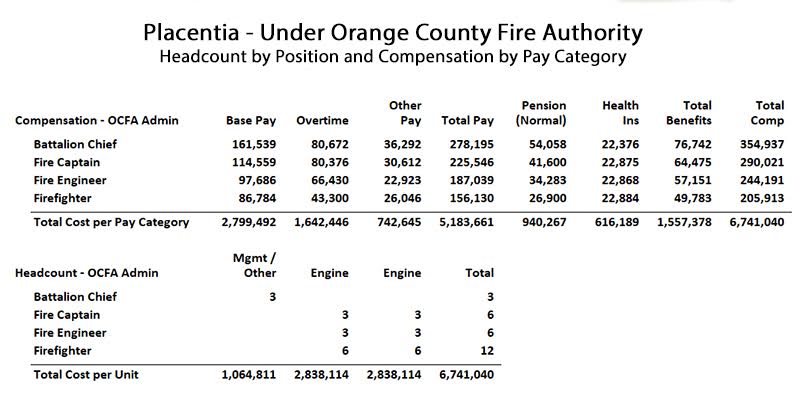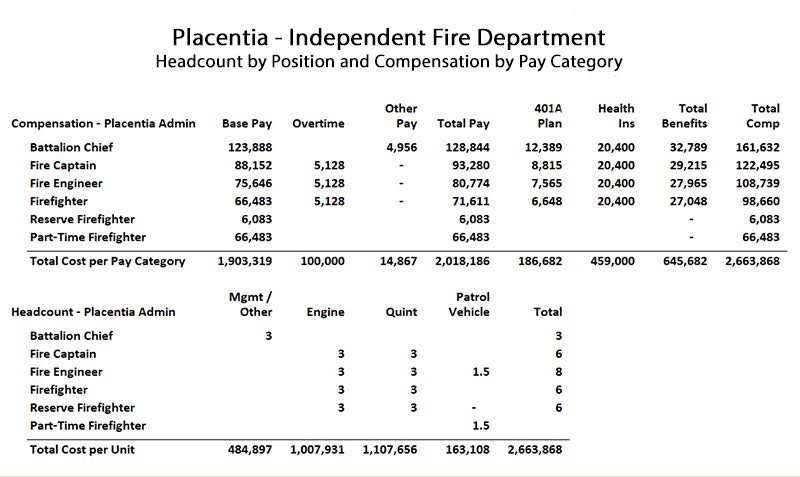
Orange County Fire Authority. (Photo: Youtube)
Firefighting in Orange County – Part Two, Building an Independent Fire Dept
What Placentia has done with pensions is revolutionary – they have done away with them, replacing them with a 401A plan
By Edward Ring, June 25, 2020 2:05 am
This is Part ll of Firefighting in Orange County. Part l is HERE.
On July 1 the City of Placentia will begin to operate a fire department independent of the Orange County Fire Authority. The motivation for the Placentia’s City Council to take this step was to provide equal or greater service at a lower cost. In this report, those cost savings will be summarized. The figures cited in this report were gathered using 2018 payroll data provided to the state controller, budget documents available from the City of Placentia, as well as via numerous conversations with local elected officials, city staff, and outside consultants familiar with the project.
Providing these estimated savings in a format detailed enough to be useful, yet brief enough to be readily absorbed by policymakers and interested observers, required use of assumptions and projections which are open to interpretation. This is freely acknowledged, and readers are invited to offer alternative interpretations as well as any information that may have been incorrect or overlooked. Taking all of that into account, however, it appears clear that Placentia will save significantly over the next several years by forming an independent fire department.
The first step in understanding how much Placentia will save is to consider what Placentia was paying to the Orange County Fire Authority in the most recent fiscal year which ends this June 30. In the first chart, below, these costs are estimated. The first set of rows shows the average annual pay in 2018, by category of pay, for OCFA’s four primary operating positions. How these pay averages were derived were discussed in detail in part one. The second set of rows shows headcount by position.
It turned out to be a controversial topic, to determine exactly what firefighting personnel and firefighting equipment Placentia was getting in exchange for the $7.1 million they paid to OCFA in the fiscal year ending 6/30/2020. OCFA maintained that a 3rd engine was provided, in addition to the two noted on the chart. But when asked about this, officials and informed observers repeatedly stated that the 3rd engine was only based in Placentia because there was not a station in the neighboring city of Yorba Linda (also an OCFA client) that could accommodate it, and that 85 percent of the use of that truck was for service into Yorba Linda. In fact, OCFA agreed in 2016 to relocate this engine, but because of the lack of space in Yorba Linda, it stayed in Placentia even though it primarily served Yorba Linda during this time.
To understand the staffing, assuming two engines were what Placentia was actually paying for, the chart shows each engine’s crew time three. Firefighters typically work two 24 hour shifts, then get four days off, which means that every piece of equipment has assigned to it three times as many full time employees as required to operate it during any given 24 hour shift. Thus under OCFA’s regime, an engine would have one Fire Captain, one Fire Engineer, and two Firefighters.
Several interesting facts are evident on this chart. It can be seen that of the $6.7 million this chart projects as direct operating costs incurred by OCFA to serve Placentia, as much as $1.6 million may have been paid in overtime. Please note the cost estimates here represent 2018 averages for all of OCFA’s operations, so what occurred specifically in Placentia could differ. But it is accurate to say overtime costs are a major cost.
Another major cost is so-called “other pay,” which is applied on top of base pay in exchange for firefighters obtaining additional training and skills, as well as pension expenses, which are discussed in detail in part one of this series.
The next chart, below, attempts to depict the planned compensation packages and staffing for Placentia’s new and independent fire department. Several major changes distinguish Placentia’s model from the OCFA model it replaces. Most significant among them are how they plan to minimize overtime costs, other pay, and pension costs, as well as how they plan to make use of “reserve firefighters.”
With respect to overtime, Placentia has budgeted $100,000 in FY 2020-21 for fire department overtime, which is a small fraction of what OCFA pays their firefighters. The reason they can accomplish this is because they plan on staffing, as appropriate, either part-time firefighters (typically firefighters who already work for other agencies), or reserve firefighters. As a result, they believe the necessity to pay overtime will be significantly reduced.
While “other pay” may still be the subject of negotiation, Placentia’s model returns to what firefighter compensation used to cover. That is, if a firefighter renews or upgrades their skills and certifications, that’s part of doing their job, not grounds for additional pay. The only “other pay” formally recognized so far is for their battalion chiefs, who receive other pay equal to between 2 to 6 percent of base pay in exchange for completing higher education degrees.
What Placentia has done with pensions is revolutionary – they have done away with them, replacing them with a 401A plan. The 401A plan is a defined contribution plan, similar to the 401K plan but offering different taxation rules based on the likelihood that public employees may retire sooner than private sector employees. Placentia has set a ceiling on employer contributions to these 401A plans at 10 percent of base pay, with no other categories of pay being eligible. In addition, Placentia instituted a 4-year vesting period, which acknowledges a return on investment for personnel that may be receiving high quality training, yet decide to leave. If they don’t meet the vesting period, the funds go directly back to the City’s General Fund.
The “reserve firefighter” program is an innovation that in some respects is a back to the future move. Reserve firefighters are essentially trained volunteers, paid a stipend to work shifts alongside the full time firefighters. The difference between volunteer firefighters, at least in many cases, is that Placentia requires their reserve firefighters to fulfill State and National training standards that match and in some cases exceeds what full time firefighters typically have to fulfill, and Placentia plans to invest equally in these reserve firefighters training as their full time counterparts. Having these reserve firefighters also provides a pool of recruits to fill full time positions whenever there is turnover.
To understand how dramatic these savings are, the second half of the chart (above) depicts the planned staffing. Not only will Placentia have two heavy apparatus, but while one will be an engine (the most commonly used firefighting vehicle), but the other will be a so-called “Quint,” a huge dual-axle ladder truck that anticipates future needs in Placentia. Also planned to roll out on July 1st is a patrol vehicle, also known as a mini-pumper, which is intended to be staffed with two firefighters 12 hours per day during peak periods. Since most fires are small – kitchen grease, a dumpster set alight, an outdoor grill – this patrol vehicle can respond more rapidly with a capacity still equal to the threat, sparing wear and tear on the larger vehicles, thus extending their useful life over OCFA’s model.
Another way to generate savings is by having one of the four crew members on the larger vehicles be a reserve firefighter, and by having part-time firefighters fill in when there is an absence or a vacancy. All of these changes add up.
As can be seen, Placentia’s personnel costs, to crew three vehicles instead of two, are a fraction of what OCFA’s personnel costs were, $2.7 million to $6.7 million. Yet OCFA claims, with some justification, that Placentia was getting a bargain at $7.1 million per year, set to increase to $7.4 million in fiscal 2020-21. To understand why this is, Placentia’s additional costs need to be considered. The next chart shows what Placentia intends to spend in 2020-21, for everything associated with their new fire department.
This total cost, $5.2 million, is taken directly from the City of Placentia’s fiscal year 2020-21 budget. It reflects their anticipated total costs for their new fire department in its first year of operation. As shown, the total salaries and benefits include management and non-operating personnel. It also shows, under “other operating costs,” the cost for investigations, professional services, radio fees, staff training, supplies, uniforms, software, furniture, payments to other agencies, etc. It also reflects, under equipment leases, the full costs of the fire trucks, including a new 2nd engine that will be held in reserve.
The City of Placentia also intends to pay for a contractor to provide ambulance services, including two permanently available ambulances and a surge capacity of up to seven ambulances. The city will also have trained 911 paramedics on every vehicle. Collectively, between the paramedics and the fire crews, this increases Placentia’s totally daily first responder staffing by 67% over their current contract with OCFA and at a fraction of the cost for taxpayers.
What Placentia is doing is arguably providing better service than what they were getting before, and at a demonstrably lower cost. In 2020-21 they expect to pay $5.2 million to operate their independent fire department, whereas if they had stayed with OCFA, the cost would have been $7.4 million; a savings of thirty percent. What they are doing to manage their personnel costs is a paradigm shift, and perhaps long overdue. However much we revere firefighters, taxpayers cannot afford OCFA rates of pay and benefits, which in 2018 averaged over $240,000 each for full-time operations personnel.
How Placentia got from there – contracting with OCFA – to here – building their own independent fire department – is another story. Part three of this series will attempt to describe that process. It was not easy.
- Ringside: Will the Delta Pumps Operate at Capacity this Winter? - December 18, 2025
- Ringside: Will Advocates for More Water Supply Projects Find Unity? - December 11, 2025
- Ringside: EVs and California’s Future Demand for Electricity - December 4, 2025







Standing 0 for the City of Placentia!
A creative way to bring better service at reduced cost.
It would be nice to have this system applied to all levels of government.
Ed,
Perhaps I missed it. What is the provisions (specific benefit, est annual cost to EE and to Taxpayers) for retiree healthcare, noting that it’s a VERY VERY VERY expensive benefit Pre-Medicare (especially if all Family members are covered).